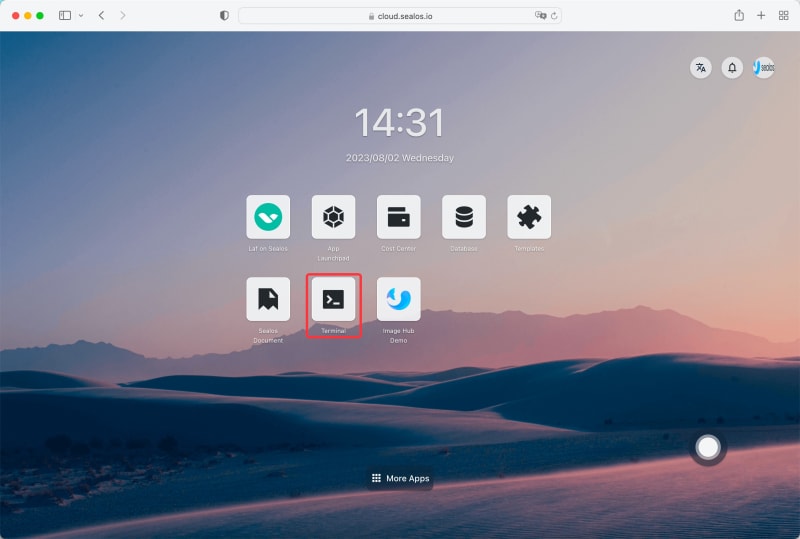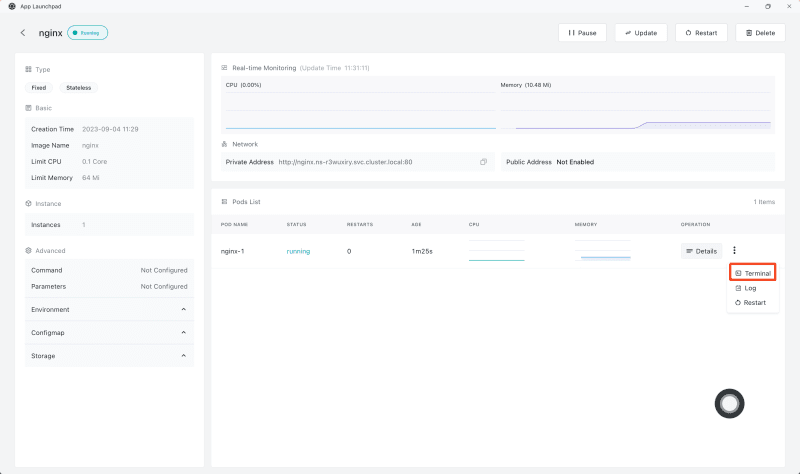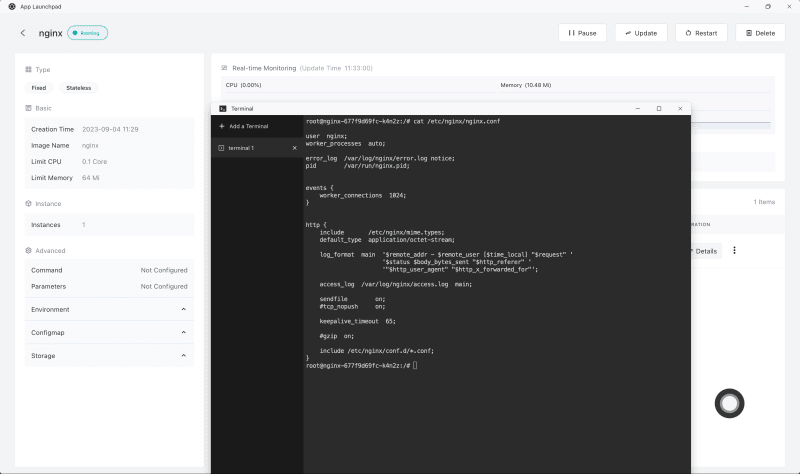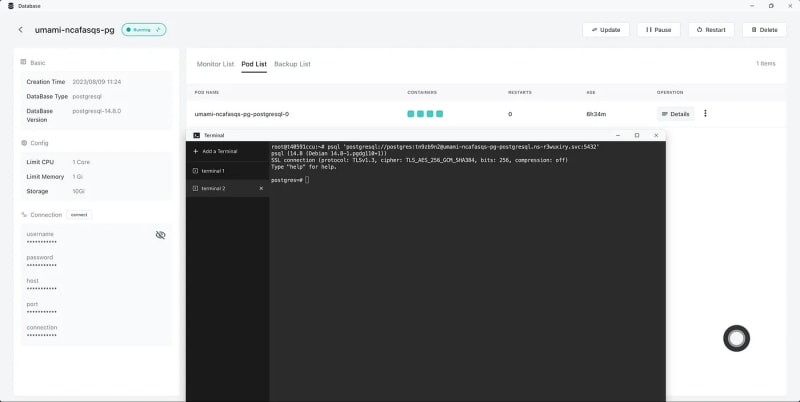In the realm of Kubernetes, utilities such as kubectl and helm serve as our principal conduits for cluster interaction. Yet, occasions arise when one might desire to instantiate a terminal directly on a webpage, bypassing the need to embed and configure these instruments locally. This treatise plunges into the intricate details of procuring this capability via Kubernetes Custom Resource Definitions (CRD), elucidating its architectural and practical facets through a tangible illustration.
The App Launchpad and Database suites within Sealos have distilled the Kubernetes resource layer's intricacies into the application stratum. Nonetheless, for more multifaceted situations, a more innate interaction with Kubernetes becomes essential.
Outlined below is the engagement with the K8s API Server via the Terminal:
Assessing Pod assets (Kubernetes' elemental scheduling unit, housing the actual container resources):
$ kubectl get pod
Surveying storage pvc resources (container-mounted storage assets, akin to those delineated in App Launchpad):
$ kubectl get pvc
Advanced Terminal Endeavors
The Terminal facilitates a plethora of sophisticated tasks.
Seamless Integration of Terminal & App Launchpad
Direct entry into each application container's terminal is achievable through the terminal app. Imagine deploying an entity like Nginx under application governance. Navigate to Nginx application's detailed interface, select the ellipsis on the detailed section's rightmost edge, and upon choosing 'Terminal', one is ushered into the Nginx application's terminal.
Unhindered Bridging of Terminal & Database
Establish an immediate linkage with the database, orchestrated in the Database App, right from the terminal.
Transition to the database's comprehensive view, and opt for the 'connect' to the left, Transition seamlessly to the Terminal and establish a direct connection with the database.
Feature Dissection
This capability's nucleus is a Kubernetes CRD christened Terminal. End-users can inaugurate a novel Terminal CRD on the webpage, post which a new Terminal materializes. This Terminal possesses rights to the designated Kubernetes Namespace, enabling execution of commands such as kubectl and helm.
Here's an archetype of a Terminal CRD:
spec:
apiServer: https://kubernetes.default.svc.cluster.local:443
ingressType: nginx
keepalived: 4h
replicas: 1
token: xxxxx
status:
availableReplicas: 1
domain: https://xxxxxx.cloud.sealos.io
CRD Field Analysis
Within the spec segment of the Terminal CRD, each field is delineated as:
-
apiServer: Kubernetes API server's nexus. Employed by the Terminal for liaisons with the Kubernetes API. -
ingressType: Ingress controller variety, eithernginxorapisix. -
keepalived: Terminal's duration. For instance,4hdenotes an automatic dissolution of the Terminal 4 hours post-inception. -
replicas: The Terminal's replication count. Presently, only a solitary replica is endorsed. -
token: Authentication token for the Kubernetes API server, harnessed for Terminal's authentication.
The status portion dissects each domain as:
-
availableReplicas: The tally of available replications. -
domain: The nexus employed for web-based Terminal interactions.
Upon the Terminal CRD's origination, a fresh Terminal manifests on the webpage. Users are equipped to run commands like kubectl and helm within this Terminal.
Architectural Blueprint & Execution
The Terminal feature's blueprint and realization comprise several pivotal elements:
Terminal Steward
The Terminal Steward stands as the linchpin of the Terminal functionality, vigilantly overseeing the genesis, modification, and dissolution events of the Terminal CRD and adapting in response.
Terminal Capsule
The Terminal Capsule epitomizes the live Terminal, hosting a bespoke Docker image laden with command-line apparatuses like kubectl and helm, alongside a web terminal server, such as ttyd. The embedded web terminal server hearkens to port 8080, delivering web terminal services.
Service & Gateway
Every Terminal CRD sees the Terminal Steward instituting a corresponding Kubernetes Service and Gateway. The Service channels traffic to the Terminal Capsule, while the Gateway navigates external access petitions to the Service.
Terminal Docker Imagery
The Docker imagery for the Terminal Capsule, founded on Ubuntu 20.04, is embellished with command-line tools including kubectl, helm, and the ttyd web terminal server. Moreover, it is augmented with MySQL, MongoDB, and Redis clients, facilitating users to connect and govern these databases directly within the Terminal.
The image's fabrication sequence unfolds as:
- Integrate vital software packages, spanning
kubectl,helm,vim, and beyond. - Implant the web terminal server
ttydand an initialization scriptstart-terminal.sh. - Designate the
ttydserver to port 8080 and calibrate its initiation parameters, which encompass the Kubernetes API server nexus and access token.
Terminal's Dissolution & Longevity
The Terminal Steward wields Kubernetes' Finalizer mechanism to address the Terminal CRD's termination events. As a Terminal CRD meets its end, the Finalizer postpones Kubernetes from immediate eradication, holding out for the Terminal Steward to clear out resources tied to the Terminal CRD (like Deployment, Service, and Gateway) before the CRD's removal.
Furthermore, the Terminal Steward capitalizes on the Keepalive mechanism, autonomously eliminating lapsed Terminal entities. The Terminal longevity, designated by the keepalived field, triggers its erasure once its existence surpasses the stipulated keepalived duration.
Interaction Schema Between the User Interface and Backend Systems
Outlined below is the meticulous progression from the moment a user engages the Terminal button to when they gain access to the Terminal:
Users activate the Terminal button on a web interface, instigating a backend request. This petition encompasses details regarding the Terminal's configuration, such as its designated Kubernetes Namespace and predetermined lifespan.
Upon assimilation of the request, the backend system spawns a novel
TerminalCRD (Custom Resource Definition) infused with the Terminal's specific configuration attributes.The vigilant
TerminalController, upon discerning the genesis of a newTerminalCRD, orchestrates the appropriateTerminalPod. This specific Pod operates a Docker image replete with command-line tools likekubectl,helm, and an embedded web terminal server.Concurrently, the
TerminalController commissions a corresponding Kubernetes Service and Ingress. This Service navigates network traffic towards theTerminalPod, whilst the Ingress directs external solicitations to the said Service.Posthaste, the backend system extracts the Terminal's domain information from the
statussegment of theTerminalCRD, relaying this domain to the frontend system.Upon reception of the Terminal's domain, the frontend system projects it onto a fresh browser tab, furnishing users with a pristine Terminal. Within this environment, users are equipped to invoke commands such as
kubectl,helm, and more.
Tailored Configurations
Assorted Ingress Controller Compatibility
The Terminal is adept at liaising with a plethora of Ingress Controllers, notably Nginx and Apisix. Users are thus empowered to elect an Ingress Controller that resonates with their distinct requirements.
Adjustable Lifespan Setting
End-users possess the prerogative to delineate the Terminal's duration of existence. Post a specified interval subsequent to its creation, the Terminal will be autonomously terminated. This strategy circumvents the undue occupation of resources by dormant Terminals.
Prospective Enhancements
Augmented Command-line Instrument Integration
Anticipated versions shall incorporate an expansive set of command-line tools within the Terminal Docker image, encompassing tools like istioctl, kn, and beyond, bestowing users with a more extensive operational gamut.
Expanded Ingress Controller Affiliation
There are blueprints to embrace supplementary Ingress Controllers such as Traefik and HAProxy, thereby diversifying users' available choices.
WebSocket Channelization
The inauguration of a WebSocket service through Ingress is cardinal. This facilitates users to inaugurate a terminal within the web facade and liaise with the Kubernetes cluster via WebSockets. When juxtaposed against HTTP, WebSockets proffer a superior real-time bi-directional communication channel, amplifying user engagement.
Granulated Access Governance
The incorporation of a refined access governance mechanism is paramount. With imminent enterprise collaborative modules, a myriad of users could coalesce within namespaces. Consequently, the terminal will access distinct user realms—be it managerial or developmental—relying on the permissions procured.
Assimilation of Diverse Development Apparatuses
Beyond the realms of kubectl and helm, the Terminal aspires to amalgamate a variety of developmental and debugging tools, including but not limited to git, curl, jq, and so forth.
User-Centric Customizations
End-users will be capacitated to modify the Terminal's visual aesthetics, such as chromatic themes, typographic dimensions, and more. Additionally, they can calibrate behavioral configurations like the archival depth of command histories, tactile shortcuts, among others.
Epilogue
Leveraging Kubernetes' CRD capabilities, we can seamlessly induct a robust Terminal within a web framework. Within this Terminal, users can seamlessly deploy an array of commands, fostering a more intimate rapport with the Kubernetes cluster. This not only optimizes their procedural workflows but also profoundly elevates their overarching interaction experience.








Top comments (0)